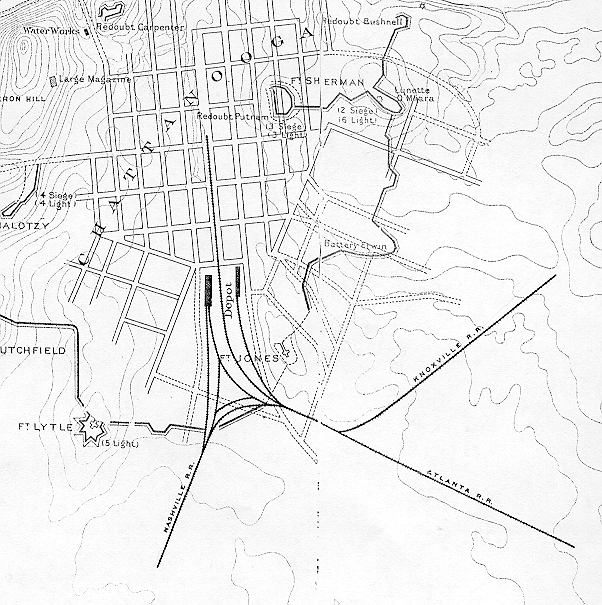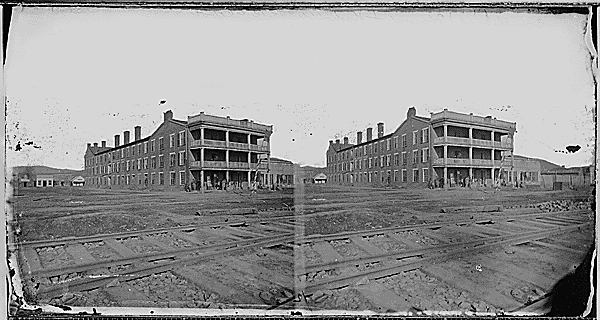 |
Chattanooga was a major railroad center in Tennessee,
strategically located between Nashville and Atlanta, and thus destined
to play a major role in the military actions that occurred in Middle Tennessee.
The rugged topography of the city complicated transportation operations
and affected the great battles fought there.
 |
As indicated in this Official Records map, three major railroads (Nashville & Chattanooga, East Tennessee & Georgia, and Western & Atlantic) converged in Chattanooga, forming a large "wye" configuration that allowed entire trains to reverse directions. Arriving trains would usually run around one leg of the wye, then back into the depot (a convenient arrangement that lasted to modern times).

USMRR freight train at Chattanooga depot with
Lookout Mountain in background
[Courtesy Library of Congress, Prints &
Photographs Division, LC-B811-2655]
After Federal forces broke the Confederate blockade of Chattanooga in November 1863, that city became the base for Sherman's Atlanta campaign. Over the next year, huge quantities of supplies and personnel moved by rail to and through Chattanooga, and Federal photographers were on hand to record those events. As depicted in the above photograph, many freight trains--typically "American" 4-4-0 locomotives pulling stings of about twenty boxcars--arrived at and left from the depots that marked the junction of the N&C, ET&G, and W&A railroads.

Confederate prisoners of war at Chattanooga
railroad depot
[Courtesy Library of Congress, Prints &
Photographs Division, LC-B811-2654]
In addition to the massive freight transfers through the critical rail center of Chattanooga, there was substantial human transportation, including Federal troops going off to war, wounded soldiers returning from battles, and--as seen in the above photograph--Confederate prisoners on their way to incarceration in Northern prison camps. The substantial brick and stone edifice on the right in the photograph closely resembles the Western & Atlantic "car shed" in Atlanta--however, the former survived the war, while the latter was completely destroyed by Sherman's forces.

Crutchfield House in Chattanooga [Courtesy
National Archives, Still Picture Branch, NWDNS-111-B-607]
As a busy railroad center, Chattanooga had to provide for the needs of rail travelers. The Crutchfield House (depicted in the stereoscopic photograph above) and similar businesses provided room and board, while sutlers and other sellers provided retail goods. Often these goods and services were quite expensive, due to wartime shortages as well as the risks of conducting business under such difficult (and even dangerous) conditions.

Rolling mill under construction at Chattanooga
[Courtesy National Archives, Still Picture
Branch, NWDNS-111-B-7018]
A significant part of Chattanooga's role as a major rail center was the provision of various railroad support services. The huge rolling mill shown above was erected by the USMRR at Chattanooga (actually an enlargement of an antebellum industrial complex), and when completed it produced massive quantities of rail for use on Federally controlled railroads. Chattanooga also offered locomotive and rolling stock repair services for the USMRR.
![]() Railroad
Junction Cities | Tennessee Civil
War Railroads | Civil War Technology
& Industry in Tennessee
Railroad
Junction Cities | Tennessee Civil
War Railroads | Civil War Technology
& Industry in Tennessee
Last update: May 9, 2000